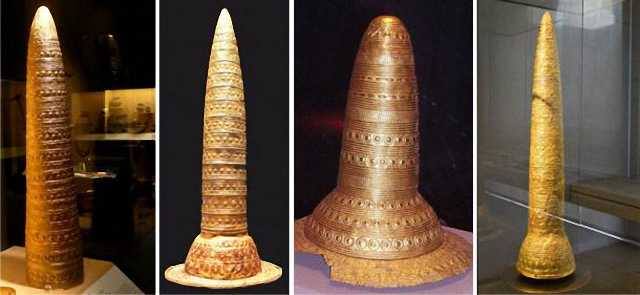In total, history knows four such hats, named after the places where they were discovered. Scientists believe that they were all produced and used in the Bronze Age, that is, no later than 800 BC. And to be more precise, in the middle of this period.
The first gold hat was discovered in Germany in 1835. Looking ahead I will say that all such headgear are similar: they are made of bronze and gold and are covered with neat ornaments consisting of rings and dots. Each of them had a main cone and not very wide fields. And perhaps the only difference was the height of the base. For example, the first of the finds was the lowest – its height “only” 29.6 centimeters.
The second specimen was discovered in France in 1844. It has a 55-centimeter cone. Unfortunately, this artifact survived much worse – its field was broken and lost, and archaeologists got only a foundation.
The third, the highest (88 centimeters), the find was discovered in the middle of the last century. It was again found on the territory of Germany, but already near another city. If the homeland of the first is a small town Schifferdstadt, the second “German” specimen was found in Bugtanna – the southernmost region of the state.
The fourth, and the last at the moment, hat was accidentally found in Swabia – a historic area in the south-west of Germany. This discovery was made in the early 90-ies of the last century. The government acquired it, and the artifact took its rightful place in the Berlin Museum. Most likely, history will repeatedly present us with such gifts, but at the moment there are no prerequisites for this or hints on the location of other copies.
What is the purpose of this amazing headgear? Scientists can not yet find an answer to it, and are lost in conjecture. It is possible that this headdress was an attribute of the priests of the cult of the Sun (there is no the deity that I spoke of yesterday), common in prehistoric Europe. This conclusion allowed to make a picture of a man with a similar object on his head, found in Sweden.
Also, a number of scientists believe that the geometric pattern on the hats could be used as the simplest calendar, but this has not been confirmed yet. Let’s hope that soon someone will be able to discover another copy, or maybe shed some light on this, no doubt, an interesting question.

